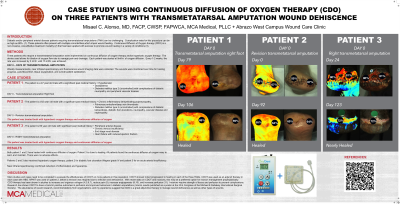Case Series/Study
(CS-004) Case Study Using EO2 (Continuous Diffusion of Oxygen therapy (CDO)) On Two Patients With Transmetatarsal Amputation Wound Dehiscence.

Diabetic patients requiring transmetatarsal (TMA) amputations can be challenging. Complication rates for this procedure can be as high as 88%[1]. These patients often come with multiple comorbidities or who may be non-compliant with traditional therapies. Continuous Diffusion of Oxygen therapy (CDO) is a non-invasive, cost-effective treatment modality that has been applied with success to promote wound healing in a variety of conditions.[2]
This poster will describe the application of CDO to TMA wound dehiscence in a series of patients with diabetes. We will present the case studies of two patients who developed a dehiscence post-op that had failed to heal with traditional treatments. CDO was applied continuously to the wounds for a period of 4-6 weeks.
Preliminary results suggest that CDO may be effective in promoting the healing of TMA wound dehiscence in diabetic patients. We will present the results of this study, including wound size reduction, time to healing, and patient perceptions of the treatment. We will also discuss the potential benefits of CDO for this patient population, including reduced pain, increased mobility, and improved quality of life.
PATIENT 1 –
The patient is a 45 year old male with a significant past medical history of hypertension, dyslipidemia, and diabetes mellitus type 2 (uncontrolled) with complications of diabetic neuropathy and peripheral vascular disease who required a right foot transmetatarsal amputation.
The patient had the following risk factors:
nicotine dependence with cigarettes
uncontrolled diabetes mellitus type 2 with complications of peripheral vascular disease
significant peripheral vascular disease
lack of adequate offloading
severe protein calorie malnourishment
active infection causing osteomyelitis and gangrene.
Post operatively, the patient’s wound slowly worsened with increased dehiscence and infection. In an effort to preserve the patient’s right foot transmetatarsal amputation, topical oxygen therapy was initiated using EO2.
PATIENT 2
The patient is a 62 year old male with a significant past medical history of chronic inflammatory demyelinating polyneuropathy, pulmonary embolism/deep vein thrombosis, diabetes mellitus type 2 (uncontrolled) with complications of diabetic ketoacidosis, diabetic foot ulcerations, neuropathy, vascular disease, and nephropathy who required a left transmetatarsal amputation.
The patient post operatively was still at substantial risk for wound dehiscence. The patient is being treated with both hyperbaric oxygen and topical oxygen therapy.
Methods:
Continuous Diffusion of Oxygen therapy (CDO)
non contact real-time fluorescence wound imaging for bacterial presence
Non contact near infrared spectroscopy studies of wound - (measurement of deoxyhemoglobin, oxyhemoglobin, and ratio of tissue oxygenation (StO2))
Results:
Discussion:
Trademarked Items:
References: [1] Pollard J, Hamilton GA, Rush SM, Ford LA. Mortality and morbidity after transmetatarsal amputation: retrospective review of 101 cases. J Foot Ankle Surg. 2006 Mar-Apr;45(2):91-7. doi: 10.1053/j.jfas.2005.12.011. PMID: 16513503.
[2] Oropallo AR, Serena TE, Armstrong DG, Niederauer MQ. Molecular Biomarkers of Oxygen Therapy in Patients with Diabetic Foot Ulcers. Biomolecules. 2021; 11(7):925. https://doi.org/10.3390/biom11070925

.png)